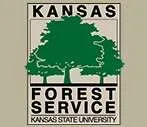Kansas Forest Service health coordinator urges landowners to look for orange spots
MANHATTAN, Kan. – In late spring, especially after a rainstorm, the careful observer may notice alien-like orange, gelatinous objects attached to the branches of their eastern redcedar trees. A Kansas Forest Service official assures it’s not the fruit of a mutant cedar — or Jell-O from Mars — but the spore-producing body of cedar-apple rust fungus.
“While a bit unusual looking, the fungus will not damage the redcedars,” said Ryan Armbrust, forest health coordinator with the Kansas Forest Service. “However, when the spores land on a susceptible leaf or fruit on an apple, crabapple or hawthorn tree, the rust fungus infects the host, leaving orange-brown spots. The infection can lead to early defoliation, stressing the tree, and can sometimes damage the fruit.”
If there is significant or repeated damage to the apples, crabapples or hawthorns, Armbrust recommends treating the trees with a fungicide in the spring when the fungus is producing spores on the redcedars.
He urges landowners to keep in mind that a product labeled for use on an ornamental crabapple may not be labeled for use on an edible-fruit-bearing apple tree.
Armbrust noted that it may be tempting to prune the redcedar branches that contain these spore-producing masses, but that’s not an effective way to control this disease. Extensive pruning can stress the tree, reduce the aesthetic value of the redcedar, and decrease its density and function as a windbreak. And even with significant pruning, cedar-apple rust galls will likely still persist throughout the tree.
Removing cedar trees in close proximity to apples and hawthorns may disrupt the lifecycle of the fungus, but be warned. According to Armbrust, the fungal spores can travel several miles from the original host tree, so removing cedars in the immediate area may not be adequate to protect the trees.
“The best bet is to avoid planting redcedars in close association with apples, and vice-versa. When selecting cultivars to plant, choose those that are resistant to rust,” Armbrust said.
A helpful publication, called Flowering Crabapples from Jason Griffin, director of the K-State John C. Pair Horticulture Center, lists many varieties of crabapple that show resistance to rust. Armbrust suggests choosing wisely to reduce the need to spray to control this disease.
About the Kansas Forest Service
The Kansas Forest Service is the nation’s fifth oldest state forestry agency. The agency serves rural landowners, communities, rural fire districts, forest and arboriculture industries, and citizens of the state through its Conservation Tree and Shrub Planting, Fire Management, Community Forestry, Rural Forestry, Marketing and Utilization, and Forest Health programs. The Kansas Forest Service state office is located in Manhattan, Kansas, just west of the campus of Kansas State University. The Kansas Forest Service is housed as an independent agency within K-State Research and Extension. The agency receives its direction from a mission statement that reads: “Care of natural resources and service to people through forestry.”
About K-State Research and Extension
K State Research and Extension is a short name for the Kansas State University Agricultural Experiment Station and Cooperative Extension Service, a program designed to generate and distribute useful knowledge for the well being of Kansans. Supported by county, state, federal and private funds, the program has county extension offices, experiment fields, area extension offices and regional research centers statewide. Its headquarters is on the K State campus in Manhattan. For more information, visit www.ksre.ksu.edu. K-State Research and Extension is an equal opportunity provider and employer.
For more information:
Cassie Wandersee
Communications Coordinator
Kansas Forest Service
785-532-3308
[email protected]



